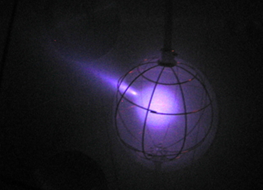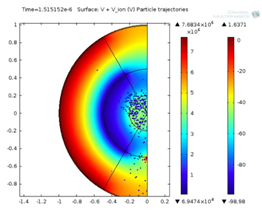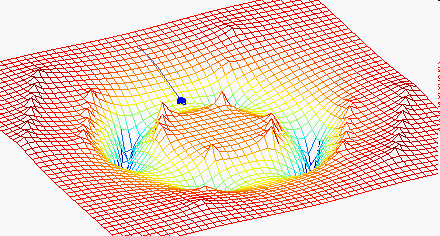Sponsors: N/A
Collaborators: N/A
 To meet the high power and low specific mass (kg/kW) requirements to enable deep space missions as well as manned missions to mars with round trip times under one year, fusion power is being pursued as a potential solution for high thrust, high specific impulse electric propulsion systems in development. Through computational research, the SPPL is developing a multi-grid Inertial Electrostatic Confinement (IEC) device to improve ion confinement times and reduce energy losses compared to traditional IEC devices. The IEC consists of concentric spherical grids (~98% transparent) to confine fast moving plasma ions to radial trajectories. An inner negatively charged grid is held at a low potential to accelerate ions towards the center. Additional positively charged grids are placed inside and outside of the negative grid to focus the ion beams and reduce thermalization and ion collisions with grid wires. Through each cycle, an ion passing through the device core may collide with a counter-streaming ion, overcome the mutual electrostatic repulsion, and produce a fusion event.
To meet the high power and low specific mass (kg/kW) requirements to enable deep space missions as well as manned missions to mars with round trip times under one year, fusion power is being pursued as a potential solution for high thrust, high specific impulse electric propulsion systems in development. Through computational research, the SPPL is developing a multi-grid Inertial Electrostatic Confinement (IEC) device to improve ion confinement times and reduce energy losses compared to traditional IEC devices. The IEC consists of concentric spherical grids (~98% transparent) to confine fast moving plasma ions to radial trajectories. An inner negatively charged grid is held at a low potential to accelerate ions towards the center. Additional positively charged grids are placed inside and outside of the negative grid to focus the ion beams and reduce thermalization and ion collisions with grid wires. Through each cycle, an ion passing through the device core may collide with a counter-streaming ion, overcome the mutual electrostatic repulsion, and produce a fusion event.
 Computational simulation of such a system requires the numerical modeling of a non-thermal, non-equilibrium, cyclically advecting plasma. Both particle-in-cell and fluid models have been developed, with a current focus on the latter. To model the ions as a fluid, a 9 point stencil, total variation diminishing (TVD) numerical scheme that does not erroneously damp advecting maxima is used. To decrease computation times, the code is parallelized with CUDA and executed on a high performance graphics processing unit (GPU). Data visualization is performed in MATLAB.
Computational simulation of such a system requires the numerical modeling of a non-thermal, non-equilibrium, cyclically advecting plasma. Both particle-in-cell and fluid models have been developed, with a current focus on the latter. To model the ions as a fluid, a 9 point stencil, total variation diminishing (TVD) numerical scheme that does not erroneously damp advecting maxima is used. To decrease computation times, the code is parallelized with CUDA and executed on a high performance graphics processing unit (GPU). Data visualization is performed in MATLAB.
The fusion power generated in an IEC system is proportional to the square of the ion density in the core of the device. Therefore, to maximize fusion power, the ion beams must be focused to minimize beam radius in the device center. However, the focusing of a beam composed of only positively charged particles will be limited by self-repulsion, thus decreasing the efficiency of the IEC device.
 Electrons confined in the device core by permanent magnets can minimize the effects of self-repulsion and neutralize the beam.
Electrons confined in the device core by permanent magnets can minimize the effects of self-repulsion and neutralize the beam.
The configuration of the IEC device is optimized using a simulated annealing routine implemented in MATLAB. To reduce computation time for the optimization routine, the ions are modeled using the paraxial ray approximation.
The motion of the electrons in the device core is modeled using COMSOL.